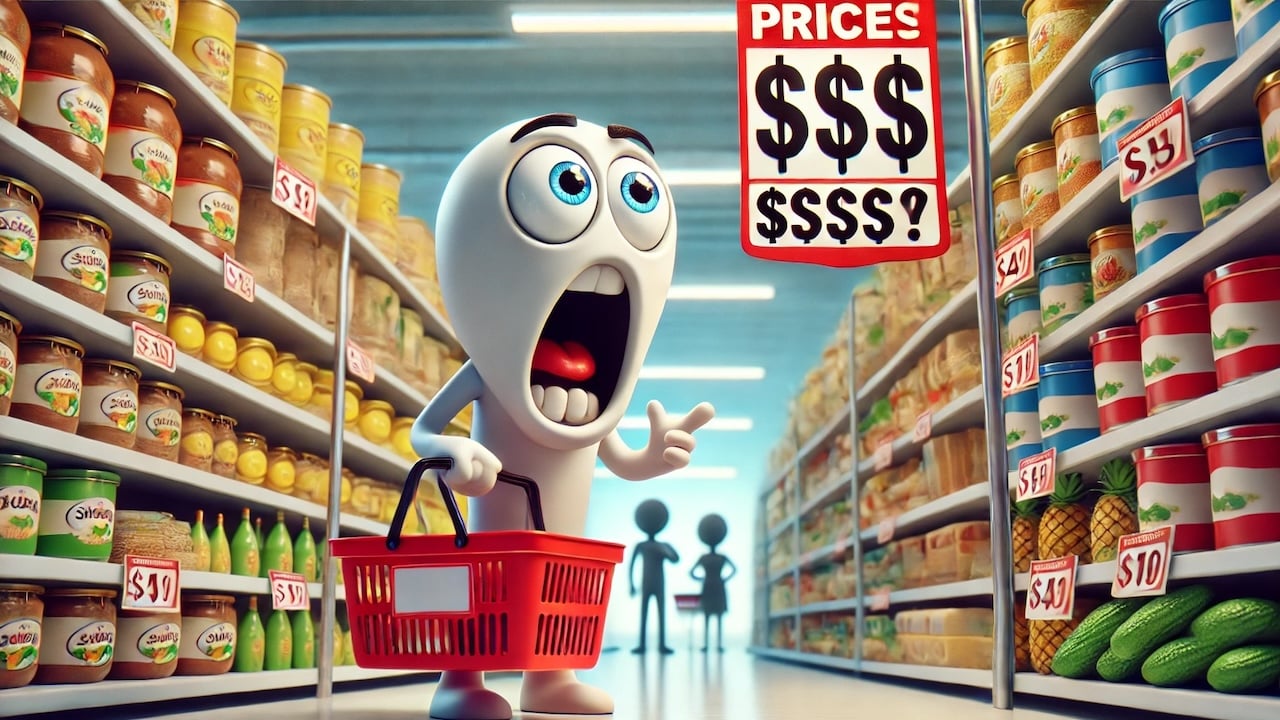(Mike Maharrey, Money Metals News Service) The political class keeps gaslighting us and trying to convince us that price inflation isn’t as bad as we think.
The fact is it’s probably worse than we think.
People like Paul Krugman keep saying Americans don’t realize how good they have it. Treasury Secretary Janet Yellen recently said she doesn’t experience sticker shock when she goes to the grocery. The White House spokesperson gets on the podium day after day telling us how great the economy is. Inflation is coming down, don’t ya know?!
Meanwhile, the rest of us are struggling to pay the bills.
How bad is it out there for the average person?
Well, a TikToker who goes by Sewerlidd discovered an option to reorder a 2022 grocery list from Walmart. The 45 essential items cost $127 when he ordered them two years ago.
And what did that same basket of items cost today?
$414.
You read that right. The cost of a basket of identical goods nearly quadrupled in just two years.
That’s a 226 percent increase, making the annual food price inflation rate 113 percent.
“I feel like I’m going to be sick,” Sewerlidd said.
We all feel that Sewerlidd. We all feel it.
Why Is There Such a Discrepancy Between Government Data and Real Life?
How in the world did prices go up that much when the official CPI is only running 3.3 percent? Heck, even at its peak in June 2022, CPI was just a little over 9.1 percent.
If you think the government numbers might be understating the problem, you’re right.
The government CPI formula was sketchy, to begin with, and then the government revised the formula in the 1990s so that it understates the actual rise in prices even more than it used to.
The BLS calculates CPI by analyzing the total price of a “basket of goods.” Obviously, the things the government chooses to put in that basket and the weight it assigns to each category have a big impact on the final CPI number.
Under the current formula, 10.9 percent of the CPI is based on durable goods (computers, automobiles, appliances, etc.). Nondurable goods, primarily energy and food costs, make up 26.6 percent of CPI. Services including healthcare, rent, internet and cell phone service, etc. account for the remaining 62.5 percent of the basket.
So, why these particular divisions and percentages?
Because the government number crunchers decided it should be that way.
In other words, it’s arbitrary.
The people who created the formula would almost certainly claim they based it on some kind of objective methodology. They would make it sound sciency. But when you boil it all down, the things in the formula are in the formula because a relatively small group of government people decided that’s the way it should be.
You don’t have to be a total cynic to recognize there is a lot of room for bias in creating or changing the formula. It’s also reasonable to assume that government people are going to be biased toward making the government look as good as possible.
In 1998, it made wholesale changes to the CPI calculation because the powers that be decided the data was “overstating” inflation.
If you run today’s data through the 1970s formula, CPI would be about double what the government reports today. In other words, that 9.1 percent CPI reported in June ’22 would have been over 18 percent in the 1970s.
The bottom line is we should never trust the government’s bottom line.
The Inflation Problem Makes More Sense if You Understand Inflation
During her recent interview, Yellen blamed “cost increases, including labor cost increases that grocery firms have experienced” for rising food prices. She also said there might be “some increase in margins.”
She missed the real cause of price inflation.
Her. And her friends in government and at the Federal Reserve.
Inflation isn’t just rising prices. Price inflation is a symptom of a more fundamental type of inflation – monetary inflation.
As economist Milton Friedman once quipped, “[Inflation] is always and everywhere a monetary phenomenon. It’s always and everywhere a result of too much money.”
Simply put, central bank money creation is inflation. One of the symptoms of this monetary inflation is rising consumer prices.
Economist Henry Hazlitt explained it this way in “Inflation in One Page:“
“Inflation is an increase in the quantity of money and credit. Its chief consequence is soaring prices.
“Therefore inflation—if we misuse the term to mean the rising prices themselves—is caused solely by printing more money. For this the government’s monetary policies are entirely responsible.” (Emphasis added)
When you understand the real cause of price inflation, everything makes sense.
During the pandemic, the Fed pumped nearly $5 trillion in new money into the economy through quantitative easing alone. That doesn’t even factor in the amount of new money created because of bank lending spurred by artificially low interest rates. That is on top of nearly $4 trillion created in the aftermath of the 2008 financial crisis. With all of that new money sloshing around chasing the same amount of goods and services, prices were bound to rise.
Of course, government people never want to look in the mirror. They want you to think they’re saving you, not making your life crap.
Something to keep in mind the next time some pundit or politician tells you that your economic troubles are all in your head.
You also may want to think about preserving your wealth with an inflation hedge. Gold and silver are ideal in that capacity!
Mike Maharrey is a journalist and market analyst for MoneyMetals.com with over a decade of experience in precious metals. He holds a BS in accounting from the University of Kentucky and a BA in journalism from the University of South Florida.

